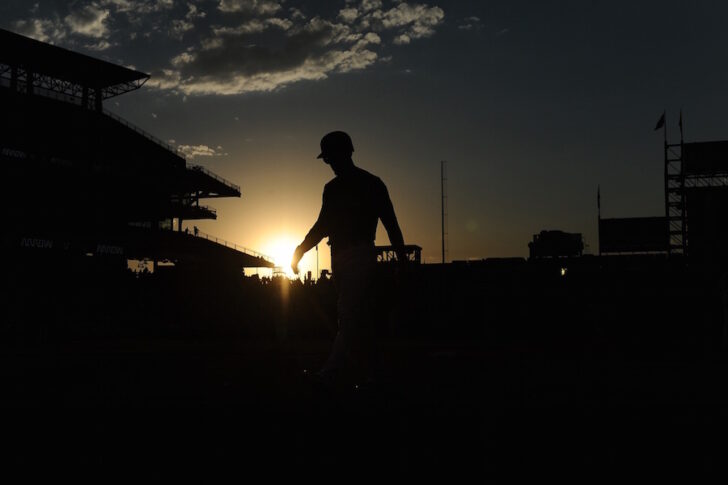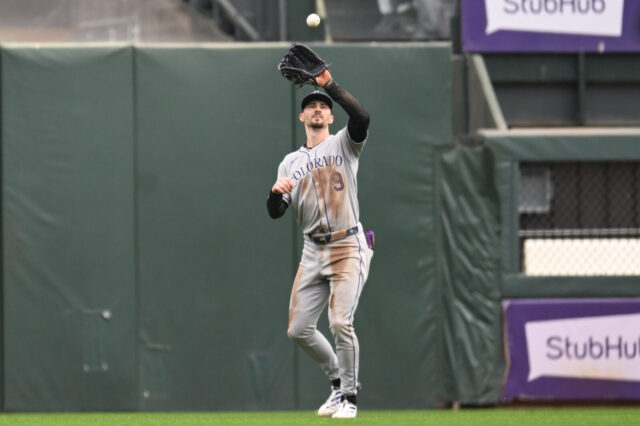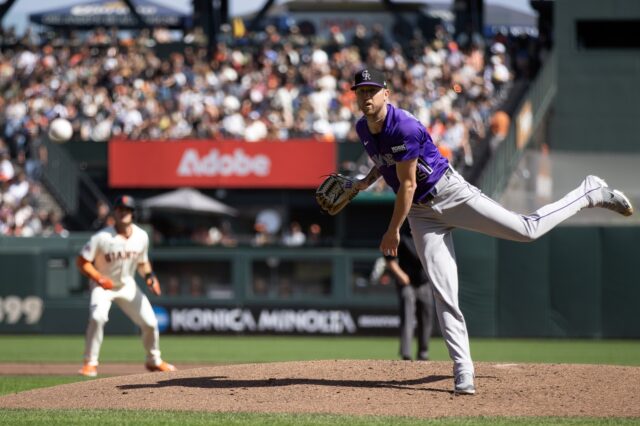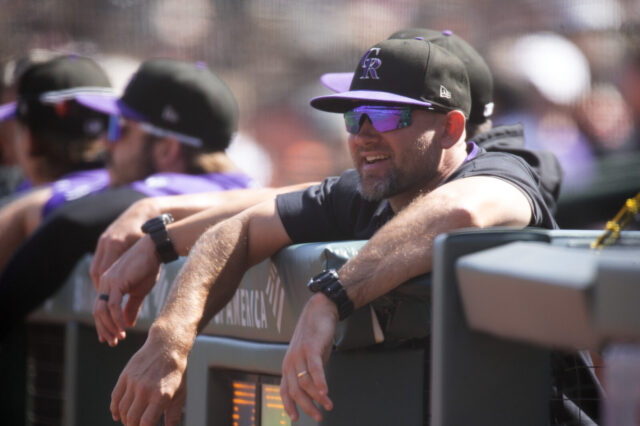On Friday, the Colorado Rockies are scheduled to open the home portion of their 2018 season at Coors Field… and in Denver, it’s expected to snow. To much of the country, snow seemed like reason enough to keep Major League Baseball away from Denver for its first 124 years, but baseball in Colorado actually pre-dates the major leagues, and love for the sport runs deep in the Centennial State.
From the first Colorado sports champion — the 1886 Denver Mountain Lions, who won the Western League — to Broadway Park and the African-American Denver White Elephants, and on to Merchants Park and the barnstorming days of Babe Ruth, Lou Gehrig and Satchel Paige, baseball has run through Colorado’s blood for almost as long as it’s been a state.
The minor-league Denver Bears/Zephyrs counted many of baseball’s future stars among its ranks — future Hall of Famers Tim Raines, Andre Dawson, Phil Niekro and Barry Larkin, fan favorites Johnny Pesky, “Marvelous” Marv Throneberry and Bob Uecker, future managerial greats Tony LaRussa, Tom Lasorda and Terry Francona (legendary Yankees manager Billy Martin‘s first job as a skipper came with the Bears in 1968), and even a young string bean named Gary Sheffield, waggling his bat and playing shortstop — fans have watched them all come through town, keeping generations involved with the game, even at arm’s length from the major leagues.
Children in Colorado have always gone out into parks and fields and thrown the hardball around like kids all over the country; putting ‘ghost runners’ on base in an imaginary bottom of the ninth where they’ve become their favorite major leaguer — but only this most recent generation has grown up imagining themselves as players for the hometown team.
The Rockies were ‘born’ in 1991, when Major League Baseball announced expansion franchises in Colorado and Florida, and started play in 1993 (meaning that the Rockies’ 25th anniversary will actually celebrate their 26th season), where hometown fans instantly fell in love — Eric Young made sure of that.
The Rockies obliterated attendance records in Mile High Stadium — which, ironically, began its life as Bears Stadium in 1948, 12 years before the Denver Broncos would come into existence. The famed South Stands were originally built in the 1950’s as an enticement to lure a big-league team to Denver. The unexpected enthusiasm led to changes in the plans for Coors Field, which added the right-field stands in response — the top of that level is now the popular and unique ‘Rooftop’.
At the time, building at 20th and Blake Street sounded ludicrous to Denverites, who couldn’t imagine the dilapidated railway area becoming a hot spot for baseball. They couldn’t have been more wrong: Coors Field would immediately begin to re-invent Denver from the inside out.
The 1994 season ended on August 12, when baseball’s owners locked the players out during a financial squabble, canceling the World Series and accelerating the eventual demise of the Montreal Expos, who were baseball’s best team with a 74-40 record and an array of superstars, one of which would factor prominently into Rockies history… more on that later.
Baseball’s popularity sank like a stone across the country, and when Coors Field opened to the public in 1995, it was for an exhibition game between the Yankees and the Rockies — both teams used replacement players in a game that’s been all but washed away from collective memory. After the Supreme Court stepped in and reversed the owners’ lockout on March 31, clubs hastily arranged an abbreviated Spring Training and began the season on April 26. In Coors Field’s ‘official’ debut, the Rockies toppled the Mets 11-9 in a chilly, 14-inning spectacle that ended with Dante Bichette‘s home run and iconic fist pump.
The Rockies would go on to make their first postseason appearance in the abbreviated season, and give birth to the “Blake Street Bombers” — Bichette, Andres Galarraga, Vinny Castilla and Larry Walker — a nickname that came to symbolize the team itself to this very day. The Expos, who were decimated financially by the lockout, had to slash payroll and allowed Walker to reach free agency. The Rockies signed him to a four-year, $22.5 million contract — the biggest post-strike contract in baseball at the time. Walker, who’s name is still littered across nearly all of the Rockies’ all-time records, went on to become the best all-around player in team history; only longtime first baseman Todd Helton and current third baseman Nolan Arenado even come close.
A cavalcade of talented players and entertaining teams has followed since. The “Rocktober” team of 2007 won the club’s first and only National League pennant in an extraordinary run of play that may never be duplicated in the majors — and no one will ever know for sure if Matt Holliday touched the plate. Another postseason appearance followed in 2009, and it wasn’t until last season that the Rockies would get there again; an all-too-brief, one-game cameo appearance that has led to sky-high expectations for the 2018 campaign.
The nature of baseball — played almost daily thanks to its 162-game schedule, has the benefit of the summer; a powerful enticement to go out to the park for an evening… and out on the town both before and after the game. As the Rockies wove themselves into the fabric of Colorado life after moving into Coors Field, the rebirth of one of Denver’s most historic neighborhoods began, spurred by tens of thousands of fans walking its streets every day — all looking for their own unique, enjoyable experience in ‘Lower Downtown’, which came to be known as ‘LoDo’.
The district’s vibe — upscale and fresh with one eye fixed on the future, and the other dutifully respecting Denver’s pioneer history — became the defining feature of the entire city. In the more than two decades that followed the Rockies’ arrival in ‘LoDo’, dozens of neighborhoods, districts and boroughs have fallen under the spell; each trying (rather successfully) to artfully mimic the historic-but-hip energy.
Today, Denver — one of the most-desired cities in America, and one that struggles with its explosive growth — is characterized almost entirely by the ‘LoDo’ style. Whether it’s the new restaurant you love, the bar you frequent, or even that trendy, retro loft you’re trying to find a way to afford, ‘LoDo’ is Denver now — the offshoot of a baseball team named after Colorado’s rocky crown of ‘fourteeners’, and wearing the purple immortalized by the ‘mountain majesties’ of Katherine Lee Bates’ “America the Beautiful”, penned upon the summit of Pikes Peak in 1893.
In 1893, the troubled Western League didn’t finish its season, leaving the 1888 Denver Mountain Lions as its defending champs. On Nov. 20 of that same year, the league reorganized under president Ban Johnson, and still exists today… as Major League Baseball’s American League.
Baseball runs through Denver’s blood, and for the last 25 years, baseball has reinvented Denver itself. The great Rogers Hornsby famously said, “People ask me what I do in winter when there’s no baseball. I’ll tell you what I do. I stare out the window and wait for spring.” Fortunately for today’s residents, there’s plenty to do in Colorado during its Currier-and-Ives winters; picturesque days that can be forgiven when they overstay their welcome and intrude upon the spring.
The snow may overstay its welcome on Friday, and if it does, you can can expect the same gnashing of teeth and flapping of gums from talking heads around the nation who will poke fun of the weather; trying to find a way to insinuate that Denver — somehow — isn’t ‘a baseball town’.
But we know better. We’ve known better for 130 years — and in the last quarter-century that the Rockies have been in Colorado, Denver’s done something extraordinary. In a city that has quite literally reshaped itself to fit its team, Denver is now, almost by definition, America’s truest ‘baseball town’.
Let’s play ball.



